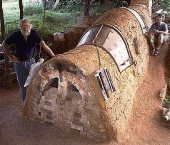
 4
4




Moderator, Treatment Free Beekeepers group on Facebook.
https://www.facebook.com/groups/treatmentfreebeekeepers/





 1
1




 1
1




Michael Cox wrote:
I'm no expert on clay or potting, but I bet there is a comparatively simple skill-set/tool-set that people could use in a homestead setting to fulfil some basic needs; fermentation vessels for sauerkraut, vessels for cooking with, preservation of summer surplus...
 1
1




 1
1




we don't have a problem with lack of water we have a problem with mismanagement
beavers the original permies farmers
If there is no one around to smell you ,do you really stink!
 1
1




 2
2




Moderator, Treatment Free Beekeepers group on Facebook.
https://www.facebook.com/groups/treatmentfreebeekeepers/





 1
1




Moderator, Treatment Free Beekeepers group on Facebook.
https://www.facebook.com/groups/treatmentfreebeekeepers/










"We're all just walking each other home." -Ram Dass
"Be a lamp, or a lifeboat, or a ladder."-Rumi
"It's all one song!" -Neil Young
 1
1















Moderator, Treatment Free Beekeepers group on Facebook.
https://www.facebook.com/groups/treatmentfreebeekeepers/





 2
2




Moderator, Treatment Free Beekeepers group on Facebook.
https://www.facebook.com/groups/treatmentfreebeekeepers/













Moderator, Treatment Free Beekeepers group on Facebook.
https://www.facebook.com/groups/treatmentfreebeekeepers/





 2
2




I no longer wish to produce anything particularly beautiful. I prefer to make useful items.
"We're all just walking each other home." -Ram Dass
"Be a lamp, or a lifeboat, or a ladder."-Rumi
"It's all one song!" -Neil Young
 1
1








Moderator, Treatment Free Beekeepers group on Facebook.
https://www.facebook.com/groups/treatmentfreebeekeepers/


















leila hamaya wrote:well like i was saying, i had a really good grasp on the skills involved....i was working in a ceramics co op and trying to do it professionally. it was my main study in college. but that was all working with purchased materials and large kilns.
it is just much harder than it could seem, imo to make a good pit kiln.
not to say i dont completely believe, but the whole bonfire things sounds a bit fishy. actually i guess i am saying i sort of dont believe that could be a very quality product produced in such a way. you might be able to get something useful enough for your own use, but it would probably not be very strong or fired enough to really be a well made ceramic piece.




 1
1




Moderator, Treatment Free Beekeepers group on Facebook.
https://www.facebook.com/groups/treatmentfreebeekeepers/





 1
1




leila hamaya wrote:thats interesting, i have never heard of anyone working in a similar way. i personally still would have doubts about how strong you could make a pot in any kind of open bonfire.
i would also think that kilns would not have been invented, were it not for a need to increase the quality of fired clay. i am sure its not at all a new idea to create either a pit kiln or a brick/earthen enclosure of some kind to capture and hold as much heat for as long as possible to make more durable ceramics.
necessity being the mother of invention and all =)
if it were that open bonfires worked well people would not have created kilns in general...
in the experimental homemade kilns with wood fire that i have made...it was a process of a couple of days to keep burning to finally get close to enough temperature. not just put it in a open fire for a bit....
 1
1




 1
1












...but most people if they were to think to replicate this would probably be very disappointed with the results, unless they had something similar, and would likely have a steep learning curve trying to make anything like an open firing work out...more than likely they would break or crack something, or still have it be only leather hard at the end. or it would be slightly "bisque" fired, if it wouldn't break, and be still very fragile...


Vicki Hardin wrote:While almost any clay can be pitfired with some care, I would recommend that you use an open body, one with some grog. Translated…ask your supplier for a raku clay or a cone six stoneware. The problem you are going to have foremost is firing without a bisque, which is the initial firing which drives the water off the clay and hardens it for glazing. A primitive firing is quite involved when you are working with pieces that have not been bisque fired because they are quite fragile when exposed the intense temperature changes involved with an open pit.










it makes me especially skeptical that someone with less to no experience, who wants to use something like this to make some pottery items for around their homestead, could work out a firing on an open bonfire and have it work. not without hundreds of pots being broken and/or not fired correctly first, at the very least. but again perhaps i am wrong and this is more viable than it seems...i still wouldn't try it!
that there is a clay body which is extremely rare.... but that there exists one place where such a clay can be found and that someone makes pots with that on an open bonfire, does not really translate to someone else who doesn't have this rare clay. with most clays this would not work at all ( as far as my understanding is), and i still no of no other clay body that works like that, not one thats commonly available. so i think that's misleading too....






















Furthering Permaculture next to Lake Ontario.
www.oswego.edu/permaculture









Furthering Permaculture next to Lake Ontario.
www.oswego.edu/permaculture








 2
2




![Filename: IMG_8709.jpeg
Description: [Thumbnail for IMG_8709.jpeg]](/t/42325/a/24193/IMG_8709.jpeg)
![Filename: IMG_8710.jpeg
Description: [Thumbnail for IMG_8710.jpeg]](/t/42325/a/24194/IMG_8710.jpeg)

| I agree. Here's the link: http://stoves2.com |






